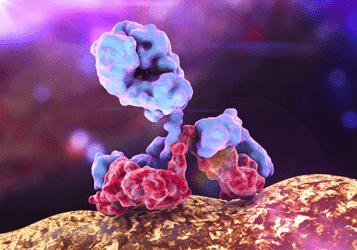- Home
- Products
- Customized ADCs
- CA9
- Anti-CA9 (Girentuximab)-SPDB-DM4 ADC
Anti-CA9 (Girentuximab)-SPDB-DM4 ADC (CAT#: ADC-W-741)
This ADC product is comprised of an anti-CA9 monoclonal antibody conjugated via a SPDB linker to DM4. The DM4 is targeted to certain cancers by immunerecognition and delivered into cancer cells via receptor mediated endocytosis. Within the cell, DM1 binds to tubulins, interrupts microtubule dynamics, and subsequently, induces cell death.
- ADC Target
- ADC Antibody
- ADC Linker
- ADC payload drug
- Name
- CA9
- Alternative Names
- CA9; carbonic anhydrase IX; carbonic anhydrase 9; CAIX; carbonic dehydratase; MN; RCC associated protein G250; pMW1; CA-IX; P54/58N; membrane antigen MN; carbonate dehydratase IX; RCC-associated antigen G250; RCC-associated protein G250; renal cell carcinoma-associated antigen G250;
- Target Entrez Gene ID
- 768
- Target UniProt ID
- Q16790
- Overview
- Carbonic anhydrases (CAs) are a large family of zinc metalloenzymes that catalyze the reversible hydration of carbon dioxide. They participate in a variety of biological processes, including respiration, calcification, acid-base balance, bone resorption, and the formation of aqueous humor, cerebrospinal fluid, saliva, and gastric acid. They show extensive diversity in tissue distribution and in their subcellular localization. CA IX is a transmembrane protein and is one of only two tumor-associated carbonic anhydrase isoenzymes known. It is expressed in all clear-cell renal cell carcinoma, but is not detected in normal kidney or most other normal tissues. It may be involved in cell proliferation and transformation. This gene was mapped to 17q21.2 by fluorescence in situ hybridization, however, radiation hybrid mapping localized it to 9p13-p12.
- Overview
- Chimeric Anti-CA9 IgG1-kappa antibody, Girentuximab
- Generic name
- Girentuximab
- Host animal
- Mouse
- Species Reactivity
- Human
- Name
- SPDB (N-succinimidyl-4-(2-pyridyldithio)butyrate)
- Description
- Disulfide Linkers, are extensively exploited as a chemically labile linkage. Since the release of disulfide-linked drugs requires a cytoplasmic thiol cofactor, such as glutathione (GSH). Disulfides maintain stable at physiological pH and only when ADCs are internalized inside cells, the cytosol provides reducing environment including intracellular enzyme protein disulfide isomerase, or similar enzymes, drugs can be released.
- Name
- DM4 (N2'-Deacetyl-N2'-(4-mercapto-4-methyl-1-oxopentyl)maytansine)
- Description
- Derived from Maytansinoid,a group of cytotoxins structurally similar to rifamycin, geldanamycin, and ansatrienin. The eponymous natural cytotoxic agent maytansine is a 19-member lactam (ansa macrolide) structure originally isolated from the Ethiopian shrub Maytenus ovatus. Maytansinoids can bind to tubulin at or near the vinblastine-binding site, which interfere the formation of microtubules and depolymerize already formed microtubules, inducing mitotic arrest in the intoxicated cells.
For Research Use Only. NOT FOR CLINICAL USE.
Related Products
- Anti-TNF (Infliximab)-MC-Vc-PAB-MMAE ADC (CAT#: ADC-W-1835)
- Anti-EGFR (Panitumumab)-SPDB-DM4 ADC (CAT#: ADC-W-1041)
- Anti-IL22 (Fezakinumab)-MC-Vc-PAB-MMAE ADC (CAT#: ADC-W-1343)
- Anti-GD2 (Dinutuximab)-MC-MMAF ADC (CAT#: ADC-W-2008)
- Anti-TNFRSF12 (Enavatuzumab)-MC-Vc-PAB-MMAE ADC (CAT#: ADC-W-1901)
- Anti-ERBB2 (trastuzumab)-Aminocaproyl-MMAE ADC (CAT#: ADC-W-627)
- Anti-EGFR (Zalutumumab)-SMCC-DM1 ADC (CAT#: ADC-W-2583)
- Anti-SDC1 (Indatuximab )-SMCC-DM1 ADC (CAT#: ADC-W-2510)
- Anti-TNFRSF10A (Mapatumumab)-SMCC-DM1 ADC (CAT#: ADC-W-2414)
- Anti-TPBG-Mc-MMAF ADC (CAT#: ADC-W-537)
Published Data
+ Submit Publications

Scientific Resources
Customer Reviews and FAQs
There are currently no Customer reviews or questions for ADC-W-741. Click the button above to contact us or submit your feedback about this product.
Quick Links
Other Products
Same Target
Same Linker
Same Payload
| CAT# | Product Name | Linker | Payload |
| ADC-W-744 | Anti-CA9 (Girentuximab)-MC-Vc-PAB-SN38 ADC | MC-Vc-PAB (maleimidocaproyl-valine-citrulline-p-aminobenzoyloxycarbonyl) | SN-38 (7-ethyl-10-hydroxycamptothecin) |
| ADC-W-740 | Anti-CA9 (Girentuximab)-SMCC-DM1 ADC | SMCC (N-succinimidyl 4-(Nmaleimidomethyl)cyclohexane-1-carboxylate) | DM1 (N2'-Deacetyl-N2'-(3-mercapto-1-oxopropyl)maytansine) |
| ADC-W-318 | Anti-CA9-MCC-MMAE ADC | MCC (Maleimidomethyl cyclohexane-1-carboxylate) | MMAE (Monomethyl auristatin E) |
| ADC-W-745 | Anti-CA9 (Girentuximab)-MC-Vc-PAB-DMEA-(PEG2)-duocarmycin SA ADC | MC-Vc-PAB-DMEA-(PEG2) | duocarmycin SA |
| ADC-W-742 | Anti-CA9 (Girentuximab)-MC-MMAF ADC | MC (maleimidocaproyl) | MMAF |
| CAT# | Product Name | Linker | Payload |
| ADC-W-324 | Anti-CD19-SPDB-DM4 ADC-3 | SPDB (N-succinimidyl-4-(2-pyridyldithio)butyrate) | DM4 (N2'-Deacetyl-N2'-(4-mercapto-4-methyl-1-oxopentyl)maytansine) |
| ADC-W-2611 | Anti-MS4A1 (Rituximab)-SPDB-DM4 ADC | SPDB (N-succinimidyl-4-(2-pyridyldithio)butyrate) | DM4 (N2'-Deacetyl-N2'-(4-mercapto-4-methyl-1-oxopentyl)maytansine) |
| ADC-W-2595 | Anti-ERBB2 (Trastuzumab)-SPDB-DM4 ADC | SPDB (N-succinimidyl-4-(2-pyridyldithio)butyrate) | DM4 (N2'-Deacetyl-N2'-(4-mercapto-4-methyl-1-oxopentyl)maytansine) |
| ADC-W-480 | Anti-CD33-SPDB-DM4 ADC-6 | SPDB (N-succinimidyl-4-(2-pyridyldithio)butyrate) | DM4 (N2'-Deacetyl-N2'-(4-mercapto-4-methyl-1-oxopentyl)maytansine) |
| ADC-W-320 | Anti-SDC1-SPDB-DM4 ADC | SPDB (N-succinimidyl-4-(2-pyridyldithio)butyrate) | DM4 (N2'-Deacetyl-N2'-(4-mercapto-4-methyl-1-oxopentyl)maytansine) |
| CAT# | Product Name | Linker | Payload |
| ADC-W-402 | Anti-FOLR1-sulfo-SPDB-DM4 ADC-6 | sulfo-SPDB | DM4 (N2'-Deacetyl-N2'-(4-mercapto-4-methyl-1-oxopentyl)maytansine) |
| ADC-W-516 | Anti-FOLR1-SPDB-DM4 ADC-5 | SPDB (N-succinimidyl-4-(2-pyridyldithio)butyrate) | DM4 (N2'-Deacetyl-N2'-(4-mercapto-4-methyl-1-oxopentyl)maytansine) |
| ADC-W-2599 | Anti-GPNMB (Glembatumumab)-SPDB-DM4 ADC | SPDB (N-succinimidyl-4-(2-pyridyldithio)butyrate) | DM4 (N2'-Deacetyl-N2'-(4-mercapto-4-methyl-1-oxopentyl)maytansine) |
| ADC-W-474 | Anti-MSLN-SPDB-DM4 ADC | SPDB (N-succinimidyl-4-(2-pyridyldithio)butyrate) | DM4 (N2'-Deacetyl-N2'-(4-mercapto-4-methyl-1-oxopentyl)maytansine) |
| ADC-W-2621 | Anti-NCAM1 (Lorvotuzumab )-SPDB-DM4 ADC | SPDB (N-succinimidyl-4-(2-pyridyldithio)butyrate) | DM4 (N2'-Deacetyl-N2'-(4-mercapto-4-methyl-1-oxopentyl)maytansine) |
Online Inquiry
Welcome! For price inquiries, please feel free to contact us through the form on the left side. We will get back to you as soon as possible.



